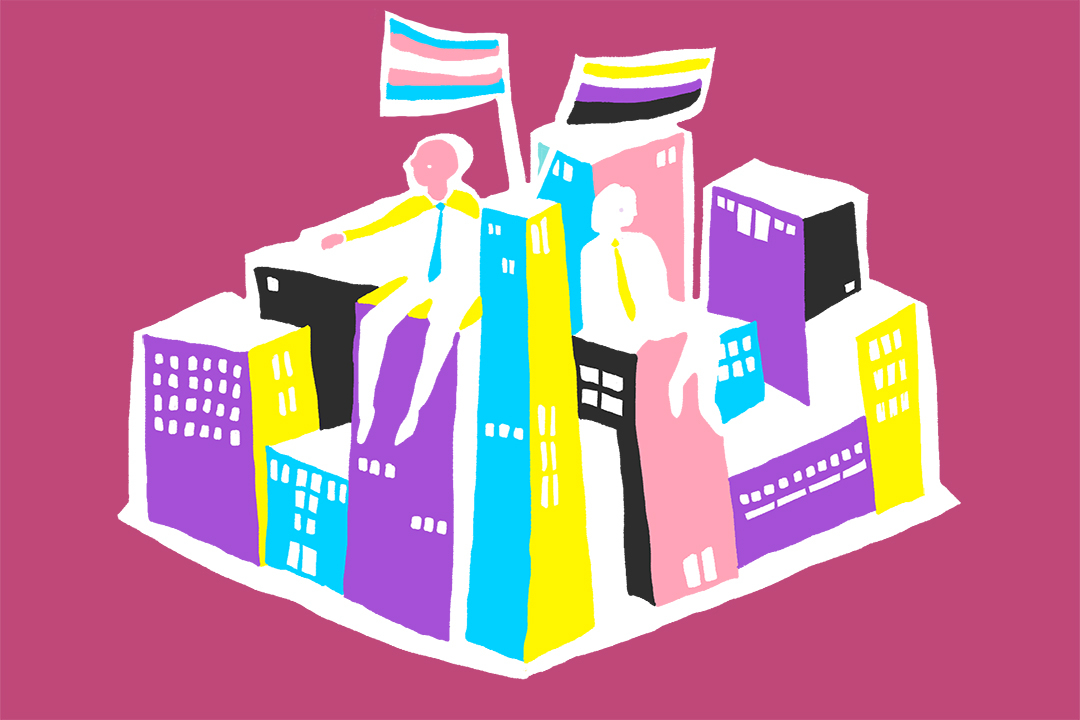Comprehensive and interactive, the 30-page career guide titled “Your Journey – A Career Guide for Trans and Non-binary Students” is a response to transgender and non-binary students’ need for customized career resources in the face of underemployment and workplace discrimination.
Released in July 2020, the guide was written by cisgender authors from the university’s Sexual and Gender Diversity Office and tri-campus career exploration and education departments. It was produced with consultation from transgender and non-binary students and alumni over two years and was illustrated by Beena Mistry, a non-binary person.
A guide in three parts
The guide begins with an invitation for readers to connect with themselves. It asks readers to reflect on and answer questions that are structured in a way to build confidence, form better connections with others, and help identify next steps. The guide then turns the lens from internal to external, providing specific and actionable advice on where and how to formally and informally connect with others for LGBTQ+ friendly career guidance.
Analyzing one’s sense of self, experiences, and interests can be a complex process when also attempting to connect those facets with one’s gender identity. The guide offers assistance with this issue from a job application angle, and emphasizes the agency transgender and non-binary individuals have over how they present themselves at each stage of the job process, including in application documents, during interviews, and after being hired. The decisions made at each step should reflect the reader’s comfort and goals.
Once a person has been hired and is on the job, they may still encounter challenges, and the guide offers advice on legal protections for gender identity and gender expression. It also includes ways in which one can respond to workplace harassment or discrimination. It addresses questions of when — and even whether — to disclose gender identity, and offers the benefits, drawbacks, and considerations one might think about when going through the decision.
A need for specialized career resources
Transgender and non-binary students face systemic and interpersonal barriers in their work and careers. The Trans PULSE Project to Inform Human Rights Policy found that 58 per cent of transgender people cannot get transcripts with their correct name or pronouns, highlighting that challenges exist even before entering the workforce.
Within the workforce, challenges increase: 13 per cent of transgender people surveyed by the study had been fired for their gender identity, and that figure did not include an additional 15 per cent who were fired but unsure of whether gender identity was the cause of termination. These factors contribute to an understanding of the economic marginalization that transgender people can face.
The report also highlights that while 44 per cent of transgender people hold postsecondary or graduate degrees, the median income for transgender people in Ontaro is only $15,000 per year, which indicates significant underemployment.
Transgender and non-binary journeys supported
While this particular resource is designed to provide support directly to transgender and non-binary people, cisgender peers, colleagues, and employers can also look to other resources to educate themselves on ways to welcome people of all gender identities. One such guide for allies is the Out & Equal Best Practices for Non-binary Inclusion in the Workplace guide.
“Your Journey” contributors Allison Burgess and Sania Hameed — U of T’s sexual & gender diversity officer and a U of T career educator, respectively — recently wrote an article for the Canadian Education and Research Institute for Counselling that indicates their aspirations for the guide’s use.
“While Your Journey won’t have all of the answers,” they explained, “we do hope that this guide serves as a useful resource for students and the staff who support them in navigating careers and the job search process.”


